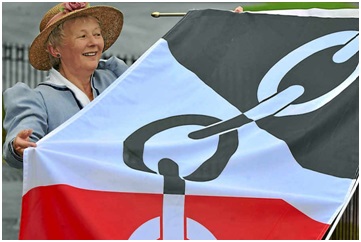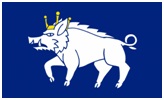The “Black Country” is an industrial heartland based on the coal seams of Staffordshire

and Worcestershire

Unlike other regions formed from Dark Age kingdoms, the area’s distinct identity is a relatively recent development, tied to the explosive growth of the industrial revolution, although even in the Civil War era, much of the iron weaponry of the conflict was being produced in the region. The term “The Black Country” dates from the 1840s, as a result, it is believed, of the black soot from heavy industries that covered the area although it has also been speculated the name may have been used even earlier as a result of the coal seams running through the area turning the soil black. The Black Country flag was the winning entry in a competition organised by the Black Country Museum, to select a design to represent the historic region. It was created by Gracie Sheppard (seen left below, at its unveiling)
a pupil from Redhill Primary School, who declared her inspiration was the famous observation of the region by Elihu Burrit
the American Consul to Birmingham in the 1860s, as “black by day and red by night” referring to the smoke and grime of the furnaces during the day and their red glow through the night. Thus the flag is composed of red and black sections with a white division between them shaped like a glass cone, a product that has been manufactured in the region since the late eighteenth century. Across the flag the “counterchanged” black and white chain illustrates another item typically produced in the Black Country – the small town of Cradley and the adjacent Cradley Heath, near Dudley, being major centres of chain production, especially for shipping. The winning design was one of six finalists
 voted on by the public, which drew nearly 1500 votes in total. More than 60 entries had been submitted. As can be seen the theme of “chains” and the colours red and black were much in evidence amongst these finalists.
voted on by the public, which drew nearly 1500 votes in total. More than 60 entries had been submitted. As can be seen the theme of “chains” and the colours red and black were much in evidence amongst these finalists.
The flag was registered following its unveiling on July 14 at the Museum’s Festival of Steam (see above photo) celebrating 300 years of the Newcomen Steam Engine. July 14th is recognised as the date that the engine, the World’s first steam engine, was erected in the area, heralding the steam age and industrial revolution. The ‘Black Country Day’ was agreed to by the museum and the Black Country Society. The flag and the commemorative date also celebrate Britain’s role in leading the industrial revolution. On the occasion, Andrew Lovett, The Director of the museum said “this design will wave the banner for the region’s unique identity, and its rich and diverse heritage”.
On the same day the flag was also raised at Eland House, the headquarters of the Department for Communities and Local Government
Eric Pickles, seen below left, holding the Black Country flag, stated
“Today it is right to celebrate the Black Country, one of England’s industrial giants. The ‘Black Country is defined by geology; it respects no human or administrative boundaries and its origins run deep. When Britain was the workshop of the world, the Black Country was the workshop of Britain. The history and identity of the Black Country is one to be proud of and cherished, and undoubtedly worthy of preservation for future generations.”
At the flag raising, Mr Pickles was joined by Dudley South MP Chris Kelly (above right holding the Black Country flag) who said, ““The history and identity of the Black Country is one to be proud of and cherished, and undoubtedly worthy of preservation for future generations…I was delighted to join Secretary of State Eric Pickles at the Department to fly the Black Country flag. I’m incredibly proud to be Black Country born, bred and educated so it’s a great honour that the minister asked for my help in promoting all that is great about Dudley and the Black Country. I would like to see more of these Black Country flags flying proudly in our area and I congratulate the Black Country Living Museum for their work on the flag.”
Stourbridge MP Margot James also congratulated Gracie Sheppard

on her design, stating “I have congratulated Gracie on what is a superb flag for the Black Country. The flag represents extremely well some of the historically important elements of the Black Country, and I am delighted that the flag was flown above the Department for Communities and Local Government last week in recognition of Black Country Day.”
And another local MP, Tom Watson declared that he wanted to make ‘Black Country Day’ an annual event emulating the annual Yorkshire Day held on August 1 when towns across the county come together to hold events.
Ann Key in 19th century costume with the Black Country Flag.
He pointed out that “Yorkshire Day has been celebrated since 1975 and I think we should replicate it in the Black Country….We should celebrate all the things that are good about the Black Country and bring the towns and city of the sub region together…I think we need to celebrate what’s great about our area and it would help those people in London who seem to have no idea about us.”
Subsequently, Philip Tibbetts of the Flag Institute and a Black Country native, suggested that the July 14th date be recognised as ‘Black Country Day’ and by December 2012 this was agreed to by both the Black Country Museum and the Black Country Society, duly appearing in the Flag Institute calendar. The date not only celebrates the Black Country’s history and flag but also Britain’s role in leading the industrial revolution. Philip next arranged for the flag to fly at the DCLG in London on Black Country Day in 2013. Following this there were local calls to do more to celebrate the date in future and in December 2013 an independent grassroots body established itself to promote the date. This developed into a month long festival of activities centred around the July 14th date with council support, with thousands of attendees. In the run up shops even
reported constantly running out of Black Country flags with one supplier resorting to ordering 9000 to cope with demand.
The scale and scope of Black Country Day has since built further. Events across most of the towns in the area comprise museum activities, guided tours, craft & industry demonstrations, beer festivals, music nights, sports tournaments, dog shows, comedy nights, car shows, educational talks, children’s activities, poetry readings, film screenings, theatre productions, tea parties, car shows, local markets, coffee mornings, discos, food tastings and town fayres with the Dudley hosting the flagship event on the closest Saturday, all put on specially. The Black Country charity road run has been moved from September to July to align with the date and businesses get behind the date with special promotions, business open days, special ales from the many local breweries, local buses even having discount fares and Black Country flag decorations. Even a dedicated phone app for the Black Country day & festival has been created.
Before the official competition was launched by the museum the notion of a flag for the region had been trumpeted by regional native Philip Tibbetts, seen at left below.
Philip followed up his design of an official tartan
for the Black Country by proposing an idea for a regional flag. Like Tom Watson, Philip had hoped a flag would put the Black Country region on the map and to help to get publicity he created a design to attract media attention in 2008.
Philip’s original black, red and yellow flag was divided by a diagonal cross or saltire, taken from the ancient Mercian flag
Its “toothed” realisation symbolised industry and “opposites meshing and working together”. The four arms of the cross represented the four boroughs of the Black Country, Wolverhampton, Dudley, Walsall and Sandwell. The black and red colour scheme was based on the Elihu Burrit quote and expanding on the theme, he placed a sun on the left quadrant and a star on the right quadrant, representing day and night. Additionally, the right quadrant was coloured red. Inside the saltire was a red and white chain representing, as seen, the heavy industry which used to dominate the area, on a black background. The four arms of the chain met in the middle to symbolise the four boroughs pulling together for the Black Country. This was further symbolised by the addition of a “coat of arms”
in the centre.
This was Philip’s first attempt at flag design. It included the rich symbolism for which he is now well known. As he became more heavily involved in the world of the Flag Institute (where he has become a renowned designer and artist for community and county flags) he refined the flag as his skills developed – reducing the elements included and removing the “arms”.
Philip spent over three years promoting the concept – the flag even inspired the Black Country Wrecking Crew wrestling team’s uniform
The team also carried his flag to bouts. Following this interest in the flag Philip was able to approach the four local councils to sanction it. Walsall was the most supportive but ultimately the concept of a Black Country flag was not seized upon by all the councils together.
However the promotion of the flag concept did take hold and eventually Philip made contact with the Black Country Living Museum who invited him in to talk over the idea. Philip suggested organising a competition and the museum was very keen to take ownership of such a competition and be guided by Philip in his capacity as Assistant to the Chief-Vexillologist of the Flag Institute. In this capacity he had already helped local towns Finchfield
and Kingswinford
to organise their own flag competitions. The museum also arranged for Philip to provide two full days of flag design workshops held within the museum itself, plus sessions with over 10 different schools from around the area. It was the museum who also brought on board the other competition stakeholders, each of whom had a representative on the “down-select panel” (which decided upon the six finalists) – the Black Country Society, the Express & Star newspaper, the University of Wolverhampton graphics department. The number and quality of designs were very high, attributable to the resources and engagement made available by the museum – ultimately the museum’s director had to be called in to make the final call! The vote itself was held on the Black Country Living Museum website and publicised by the Express and Star.
Although Philip had to agree not to submit his original design to the competition, it had achieved its intended purpose of getting the concept of the Black Country flag accepted. It is notable that several of the themes which originated with Philip’s designs appeared on the later competition finalists. In time his earlier designs helped to raise the issue of a flag for the area and Philip’s sterling work and cooperation with the Black Country Museum led to the creation of the competition.
The flag has since become very popular and is flown across the region


has been taken up with enthusiasm by locals

and is seen here embraced by celebrated local son, Sir Lenny Henry

and below, projected on to the walls of Dudley Town Hall

Useful Links
















